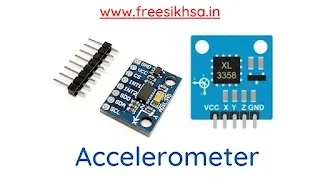What Is Accelerometer ?
An accelerometer is an electronic sensor device that is used to measure acceleration, vibration, and tilt. It is commonly used in electronic devices such as smartphones, fitness trackers, and gaming controllers, as well as in industrial and automotive applications.
Accelerometers typically consist of a small mass attached to a spring or other elastic material, which is in turn attached to a stationary frame. When the accelerometer experiences acceleration or vibration, the mass is displaced from its original position, causing the spring to deform. The deformation of the spring is then converted into an electrical signal, which is processed by the accelerometer's electronics to measure the acceleration or vibration.
Accelerometers can measure acceleration in one, two, or three dimensions, depending on the number of sensing axes. Single-axis accelerometers measure acceleration in one direction only, while two-axis accelerometers measure acceleration in two perpendicular directions, and three-axis accelerometers measure acceleration in all three directions.
Type Of Accelerometer :
There are several types of accelerometers, each with its own characteristics and advantages. Here are some of the most common types:
- Piezoelectric accelerometers: These accelerometers use a crystal that generates a voltage in response to mechanical stress. When the crystal is subjected to acceleration or vibration, it generates a voltage proportional to the acceleration. Piezoelectric accelerometers are commonly used in industrial and automotive applications due to their ruggedness and high sensitivity.
- Capacitive accelerometers: These accelerometers use a capacitive sensing element to measure acceleration. The sensing element consists of two parallel plates, one of which is fixed and the other moves in response to acceleration. The capacitance between the plates changes with the displacement, which is measured to determine the acceleration. Capacitive accelerometers are known for their low power consumption and high accuracy.
- Micro-electromechanical system (MEMS) accelerometers: These accelerometers use micro-scale mechanical components, such as springs and beams, to measure acceleration. MEMS accelerometers are small, low-power, and cost-effective, making them ideal for portable and wearable devices.
- Strain gauge accelerometers: These accelerometers use a strain gauge, which is a resistive element that changes its resistance in response to mechanical stress. When the accelerometer experiences acceleration, the strain gauge deforms, causing a change in resistance that is measured to determine the acceleration. Strain gauge accelerometers are commonly used in aerospace and defense applications due to their high accuracy and reliability.
- Magnetic accelerometers: These accelerometers use the principle of electromagnetic induction to measure acceleration. When the accelerometer experiences acceleration, a magnetic mass is displaced, causing a change in the magnetic field, which induces a voltage in a coil. The induced voltage is measured to determine the acceleration. Magnetic accelerometers are commonly used in navigation systems and automotive applications.
Application Of Accelerometer :
An accelerometer is a device that measures acceleration, typically in terms of changes in velocity over time. It is commonly used in a variety of applications where motion needs to be monitored or controlled.
Here are some of the most common applications of accelerometers which are Used Daily:
- Automotive: Accelerometers are widely used in the automotive industry for various applications such as vehicle stability control, airbag deployment, and anti-lock braking systems.
- Aerospace: Accelerometers are used in the aerospace industry for aircraft and spacecraft guidance, navigation, and control systems.
- Consumer Electronics: Accelerometers are widely used in consumer electronics such as smartphones, tablets, and gaming consoles. They enable motion-based features such as screen rotation, tilt control, and gaming.
- Sports and Fitness: Accelerometers are used in sports and fitness tracking devices to measure activity levels, track workouts, and monitor performance.
- Robotics: Accelerometers are used in robotics to measure motion and tilt angles, and provide feedback to control systems.
- Medical: Accelerometers are used in medical devices to measure motion and vibration, such as in prosthetics and hearing aids.
- Industrial: Accelerometers are used in various industrial applications, such as monitoring the vibration levels of machinery and equipment to identify potential problems or defects.
Conclusion :
accelerometers are widely used in a variety of applications where motion needs to be monitored or controlled. From automotive to aerospace, consumer electronics to medical devices, accelerometers play a vital role in enabling motion-based features and providing critical feedback to control systems. As technology continues to advance, it is likely that we will see even more innovative uses of accelerometers in the future
Working Principle of Accelerometer :
An accelerometer is a device that measures how fast something is accelerating in any direction. It works by using a small mass and a spring system to detect the force generated by the acceleration. This force is then measured by a sensing element, which converts it into an electrical signal. The signal can then be used to control various systems or measure motion and tilt.


